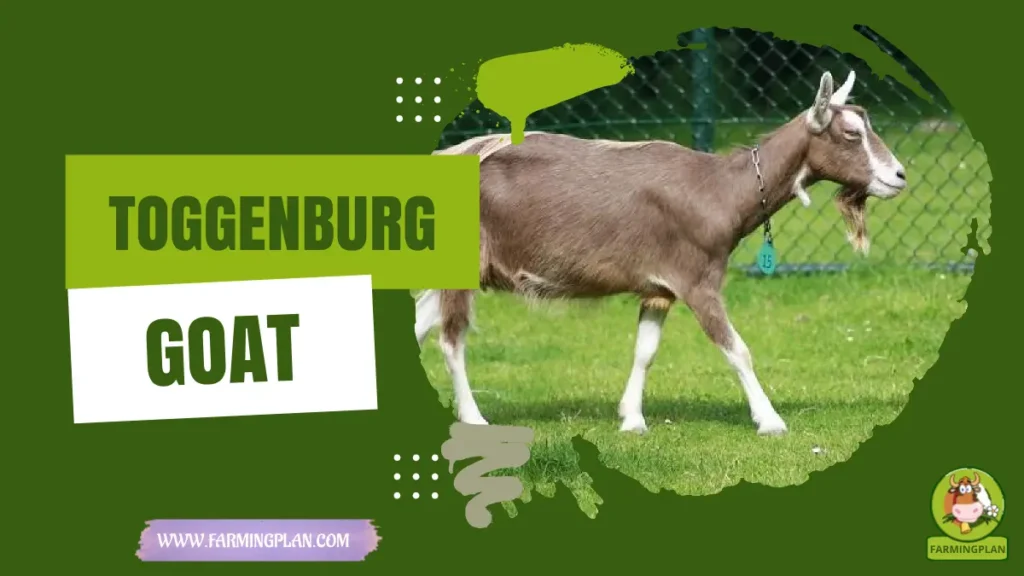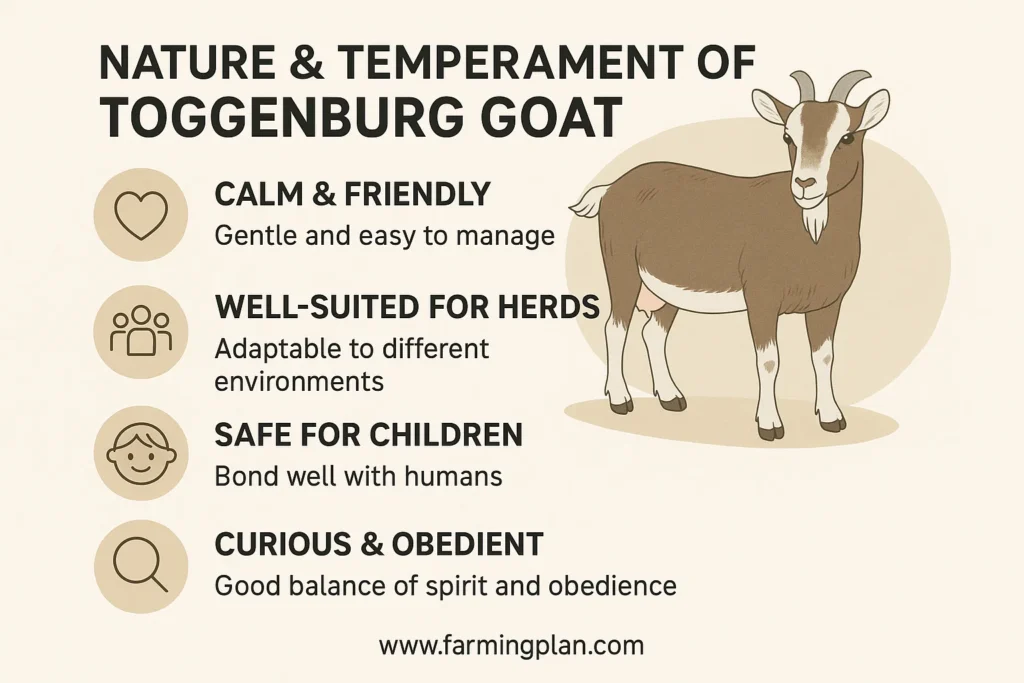If you’ve ever dreamed of owning a reliable and affectionate dairy goat, the Toggenburg Goat is a top pick. These Swiss charmers may not be flashy, but they shine with their creamy milk, calm nature, and strong work ethic. I’ve raised them on my small farm for years, and they’ve never let me down when it comes to milk production and friendly personalities. With their unique markings and dependable yields, Toggenburgs are perfect for anyone—from pet lovers to seasoned breeders. Whether you’re starting a hobby farm or expanding your herd, this guide will show you why Toggenburg goats are worth every bit of your time.

History & Origin of Toggenburg Goat
The Toggenburg Goat is one of the oldest known dairy goat breeds, originating in the Toggenburg Valley of Switzerland. Documented as far back as the 1600s, these goats have a long-standing reputation in Europe for their reliable milk production. When Swiss farmers began selective breeding for dairy traits, Toggenburgs quickly became one of the top choices.

Over time, they found their way to other parts of the world. They were first brought to the United Kingdom in the 1880s and later reached North America and South Africa. With each importation, breeders focused on preserving their signature features—compact size, straight facial lines, and creamy white markings—while also improving their milk output. Today, the breed enjoys international recognition and remains a staple among dairy goat enthusiasts.
Read More: Barbari Goat: Hardy Breed With Great Milk And Meat
Characteristics of Toggenburg Goat
On average, Toggenburg goats live for 8 to 12 years, so be prepared for a long-term commitment when you decide to bring them into your farm or home. Toggenburg goats are medium-sized animals with solid-colored coats that range from light fawn to deep chocolate. What really sets them apart are the distinctive white markings: facial stripes, white legs from hocks to hooves, and a white triangle on each side of the tail. You’ll also notice their straighter hair and compact, yet elongated body, which gives them a neat, dairy-type appearance.

Their ears are erect, and both bucks and does often have horns, though many breeders choose to disbud kids early. One thing I love about Toggenburgs is their consistent conformation. They’re sturdy without being bulky, and their appearance is refined. You’ll also spot their short, glossy coats more often in cooler climates, where they thrive best.
Read More: Australian Miniature Goat: Farming Practical
Nature & Temperament of Toggenburg Goat
Toggenburgs are calm, friendly, and smart. I’ve found them to be some of the easiest goats to manage—especially for beginners or small families. Their gentle nature and ease of management make them an ideal choice for those new to goat farming. They aren’t aggressive, and they tend to bond well with humans and other animals. If you’ve got kids (the human kind), these goats are a gentle, safe option.

They do well in herds and adapt easily to different environments, though they do prefer cooler conditions. Their adaptability ensures that they can thrive in a variety of settings, making them a versatile choice for goat farming. They’re curious by nature but not overly mischievous like some other breeds. Honestly, they’ve got just the right balance of spirit and obedience, making them a joy to raise.
Read More: Boer Goat: Secrets to Starting a Successful
Food & Diet
Toggenburg goats are ruminants, which means they need a well-balanced diet rich in fiber. Good-quality hay, such as timothy or alfalfa, should make up the bulk of their diet, supplemented with grains or pellets specifically formulated for dairy goats, especially during milking season. I also provide fresh greens, clean water, and mineral blocks to keep them healthy.
Avoid feeding them anything moldy, toxic plants like rhododendron or azaleas, or food scraps. Their sensitive digestive systems can’t handle sudden diet changes, so if you’re switching feeds, do it gradually over 7–10 days. A healthy Toggenburg is a productive Toggenburg, so I always prioritize their nutrition.
Usage & Purpose
Toggenburg goats are first and foremost a dairy breed. Their milk may not have the highest butterfat content, but it’s consistent, plentiful, and excellent for making cheese. During the peak of their lactation, which usually occurs in the first few months after kidding, you’ll need to milk them twice a day, each session lasting about 10-15 minutes. Some farmers, like me, use their milk for chevre Toggenburg—a creamy, tangy goat cheese that’s always a hit at markets.
Besides being fantastic milkers, Toggenburgs make great pets and 4-H project animals thanks to their docile personalities. You’ll also see them in goat shows, where their distinct appearance and calm demeanor help them shine. They’re not typically used for meat, but their milk production and friendly nature more than make up for it.
Special Features
One of the coolest things about Toggenburgs is their strong breed identity. From their symmetrical white markings to their sturdy build, you can spot one from a mile away. They also stand out for their consistent milk yield—even in colder climates, they keep producing.
Their intersex rate is notably lower than in some other Swiss breeds, and they tend to have well-formed teats and udders—ideal for hand or machine milking. Mini Toggenburg goats, a crossbreed with Nigerian Dwarfs, also exist for those who want the look and personality in a smaller package.
Love Your Goats Like Family, Feed Them Like Champions, And Watch Them Thrive With Every Friendly Bleat.
Health Issues & Prevention
Toggenburg goats are hardy, but they’re not invincible. Common issues include parasites, respiratory infections, and occasional hoof problems. Bucks may rarely show signs of testicular hypoplasia or cryptorchidism, so it’s important to inspect breeding stock carefully.
Regular deworming, hoof trimming, and vaccinations go a long way. I always make sure their shelter stays clean and dry to prevent respiratory issues. And don’t forget the minerals—copper and selenium deficiencies can sneak up fast, especially in dairy breeds. A healthy goat is a productive and happy goat.
Step-by-Step Farming Guide/Pet Owner Care Guide
Raising Toggenburg goats isn’t just rewarding—it’s downright fun once you get the hang of it. Whether you’re a first-time goat owner or expanding your herd, this guide walks you through each step of caring for these sturdy dairy goats. From setting up your space to daily routines, I’ll share what’s worked best for me and what you should watch out for. Let’s dive in!
Step 1: Setting Up The Shelter
Start with a clean, dry, draft-free shelter. Toggenburgs don’t like damp or overly hot environments, so make sure their housing is well-ventilated. I use deep bedding (like straw) for comfort and insulation, especially in winter.
You’ll need 15–20 square feet per goat inside and a larger, secure area outside for grazing and exercise. Fencing should be strong—these goats aren’t big escape artists, but they do like to explore. Shade in summer, wind protection in winter, and always access to fresh water are must-haves.
Step 2: Choosing Your Goats
Buy from reputable Toggenburg goat breeders. Look for clear eyes, good body condition, and no signs of nasal discharge or lameness. Ask about their milk yield, udder health, and any history of intersex traits. If you’re starting with kids, make sure they’re at least 8 weeks old and weaned.
Go for goats registered with a national or international dairy goat association, like the American Dairy Goat Association. It’s a sign of quality and breeding history. If you’re getting a buck, inspect his testicles—make sure they’re symmetrical and well-developed.
Step 3: Feeding & Watering
Feed hay twice a day, and offer grain or pellets during lactation. Don’t forget the minerals—use a loose mineral mix designed for goats, not a cattle block. Clean water should be available 24/7. I clean troughs daily to avoid algae and bacteria buildup.
I also give kitchen scraps (non-toxic ones!) and brush clippings for variety. Goats are picky and won’t eat dirty feed, so keep everything tidy. For young goats, alfalfa hay and a small amount of creep feed work wonders.
Step 4: Daily Care & Milking
Spend time with your goats every day. Check for signs of illness, like drooping ears or dull coats. Brush them weekly and trim hooves every 6–8 weeks. Toggenburgs have straighter hair, so grooming’s a breeze.
If you’re milking, do it at the same time each day. Clean the udder, use a sanitized pail, and strain and chill the milk immediately. Trust me, keeping things clean makes all the difference in taste and safety.
Expert Tips & Best Practices
Stick To A Steady Diet: Toggenburgs don’t appreciate sudden changes in their menu. If you switch up their feed too quickly, you might end up with a bunch of upset tummies. Always transition feed gradually to keep their digestion happy.
Time Breeding With The Weather: I’ve found that breeding during the cooler fall months works best. Not only does it reduce stress for both bucks and does, but the kids are born in spring, when the weather’s much more forgiving.
Track Your Milk Like A Pro: Label your milk containers and jot down each doe’s daily yield. It sounds simple, but it helps a ton when you’re trying to spot top performers or improve your herd’s productivity over time.
Keep An Eye On Those Hooves: Trust me, regular hoof trimming saves you from big headaches later. Infections and foot problems can sneak up fast, especially if the ground is wet or muddy.
Get Hands-On With The Kids: Want friendly goats? Handle the babies often! The more time you spend with them early on, the calmer and more social they’ll be as adults.
FAQ
Are Toggenburg goats good for beginners?
Yes! Their calm nature and manageable size make them perfect for first-time goat owners.
How much milk does a Toggenburg goat produce?
On average, a doe produces 2–3 liters daily, with good consistency throughout the year.
What are Toggenburg goat colors?
They range from light fawn to chocolate, with distinctive white facial lines, leg markings, and tail triangles.
Can you raise Toggenburg goats in warm climates?
They prefer cooler areas but can adapt if shaded, well-ventilated housing is provided.
Do Toggenburg goats get along with other animals?
Absolutely. They’re social and typically do well with other goats, sheep, and even calm dogs.
Conclusion
Toggenburg goats may be one of the oldest dairy breeds, but their charm, utility, and personality keep them timeless. From their steady milk production and distinct Swiss markings to their gentle temperament, they offer the perfect mix for hobby farmers, pet owners, and dairy lovers alike. With proper care, good nutrition, and a loving home, Toggenburgs will reward you with gallons of delicious milk and years of companionship. So, whether you’re starting small or looking to expand your herd, these reliable goats are always a smart choice.
